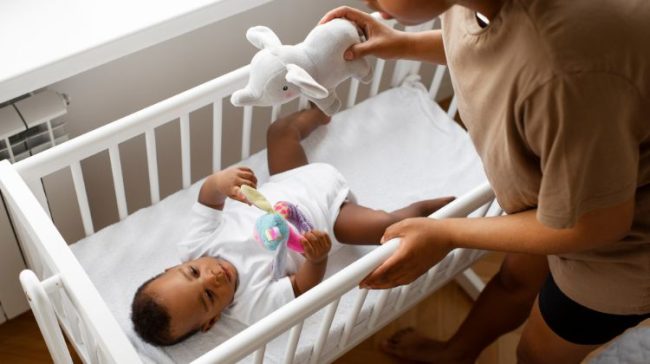Breastfeeding is a crucial part of an infant’s life, providing vital nutrients essential for growth and development. While it is a natural process, some mothers and babies face challenges that make breastfeeding painful or difficult, like latch-on problems, flat or inverted nipples, or overactive letdown. A nipple shield can be a helpful tool in these situations, acting as a protective barrier between the nipple and the baby’s mouth.
What is a Nipple Shield?
A nipple shield is a flexible silicone cover worn over the nipple and areola during breastfeeding. It has tiny holes at the tip to allow milk to pass through. Its main purpose is to aid in breastfeeding by assisting with latch difficulties, relieving nipple pain, and protecting sore or damaged nipples.
When to Use a Nipple Shield?
Before opting for a nipple shield, it is recommended to consult with a lactation consultant or healthcare provider to ensure it is the appropriate solution, as improper or unnecessary use can lead to reduced milk supply or other breastfeeding problems.
Here are some circumstances when a nipple shield might be suggested:
- Latch-on Difficulties: Some babies struggle to latch on to the breast properly due to conditions like tongue-tie or a high palate, and a nipple shield can help in such cases.
- Premature Babies: Premature infants often have a harder time latching and sucking, and a nipple shield can be useful in such scenarios.
- Flat or Inverted Nipples: Mothers with flat or inverted nipples might find that a nipple shield helps the baby latch more easily.
- Nipple Pain or Damage: For mothers experiencing extreme nipple pain or those with cracked or bleeding nipples, a nipple shield can offer relief by reducing friction during feeding.
How to Use a Nipple Shield?
Step 1: Choose the Right Size
Nipple shields come in various sizes, typically ranging from 16mm to 24mm. It’s important to select the correct size to ensure proper fit and avoid discomfort or additional nipple damage.
Step 2: Clean the Nipple Shield
Before each use, wash the nipple shield with mild soap and warm water and rinse it thoroughly. Ensure it is dry before placing it on the nipple.
Step 3: Position the Nipple Shield
Moisten the rim of the nipple shield with water or a few drops of breast milk for better adherence. Invert the shield about halfway, center it over the nipple, and smooth the edges outward around the areola. Make sure the nipple is in the tip of the shield and that there are no air bubbles.
Step 4: Encourage the Baby to Latch
Hold your breast with one hand, with the thumb above and the fingers below, forming a “C” shape. Gently touch the baby’s lips with the shield to encourage them to open their mouth wide. When the baby’s mouth is open wide, bring them onto the breast, ensuring they take as much of the breast into their mouth as possible, not just the tip of the shield.
Step 5: Monitor Milk Flow
While the baby is feeding, watch for signs of swallowing to ensure they are getting enough milk. The baby’s jaw should be moving, and you may hear or see them swallowing. If the baby seems frustrated or the shield collapses, reposition the baby and try again.
Step 6: Clean After Use
After each feeding, clean the nipple shield thoroughly with mild soap and warm water, and store it in a clean, dry place.
Important Considerations
- Temporary Solution: A nipple shield is generally considered a temporary solution to breastfeeding problems. Long-term use can potentially lead to a decrease in milk supply, so it’s important to address the underlying issues with the help of a lactation consultant or healthcare provider.
- Regular Pumping: To maintain milk supply while using a nipple shield, mothers might need to pump regularly, especially if the baby is not transferring milk efficiently.
- Weaning Off: Once the underlying issue is resolved, mothers should gradually wean the baby off the nipple shield with the guidance of a lactation consultant.
Final Thoughts
A nipple shield can be a valuable tool to aid mothers and babies facing breastfeeding challenges, facilitating a better latch and reducing pain and damage to the nipples. However, its use should be considered with caution, under professional guidance, and typically as a temporary solution. Proper sizing, correct placement, and meticulous cleaning are crucial to effectively use a nipple shield while maintaining optimal milk supply and ensuring the baby receives adequate nutrition.
Frequently Asked Questions (FAQs)
1. Can using a nipple shield reduce milk supply?
Yes, improper or prolonged use of a nipple shield can potentially lead to reduced milk supply. It can interfere with the baby’s ability to efficiently transfer milk from the breast, necessitating close monitoring and possibly supplemental pumping to maintain supply.
2. Can nipple shields cause nipple confusion in babies?
There is a concern that the use of nipple shields can cause nipple confusion in babies, where they may prefer the shield over the natural breast. However, when used appropriately and under professional guidance, many mothers find they can wean the baby off the shield without significant issues once the underlying problem is resolved.
3. How often should I clean my nipple shield?
Nipple shields should be cleaned before and after each use. Wash it with mild, unscented soap and warm water and let it air dry. Store it in a clean, dry place to avoid contamination.
4. How do I know which size nipple shield to use?
Nipple shields come in different sizes, usually ranging from 16mm to 24mm. Consult with a lactation consultant or a healthcare provider to determine the right size for you. The correct size should cover the nipple and areola comfortably without pinching or causing discomfort.
5. Can I use nipple shields for the entire duration of breastfeeding?
Nipple shields are generally recommended as a temporary solution to overcome specific breastfeeding challenges. Prolonged use may lead to reduced milk supply and other complications. It is advisable to gradually wean the baby off the nipple shield under the guidance of a lactation consultant or healthcare provider once the underlying issue is resolved.
6. Is it safe to use a nipple shield for every feed?
While it can be safe to use a nipple shield for every feed when necessary, it is crucial to address and resolve the underlying breastfeeding issues with the help of a lactation consultant or healthcare provider. Regular monitoring of baby’s weight gain, diaper output, and milk supply is crucial when using a nipple shield for every feed.
7. How can I wean my baby off a nipple shield?
To wean your baby off a nipple shield, start by offering the bare breast at the beginning of each feed when the baby is calm but hungry. If the baby resists, you can try again during the feed or at the next feeding. Gradually increase the amount of time the baby spends at the bare breast until they no longer need the shield. Seek guidance and support from a lactation consultant or healthcare provider during this process.
8. Can I use nipple cream with a nipple shield?
Yes, you can use nipple cream with a nipple shield. Applying nipple cream can help in healing sore or cracked nipples. However, ensure that the nipple cream is safe for breastfeeding and that the nipple shield is thoroughly cleaned before and after each use.
9. Is it necessary to sterilize the nipple shield after each use?
While sterilizing is the best way to ensure that the nipple shield is free from bacteria, thoroughly washing the nipple shield with mild soap and warm water after each use is usually sufficient. However, sterilizing at least once a day is recommended, especially if the baby is premature or has a compromised immune system.
10. Can I share my nipple shield with another breastfeeding mother?
No, sharing nipple shields is not recommended due to the risk of transferring infections or bacteria between mothers and babies. Each mother should have her own nipple shield, which should be kept clean and stored properly to avoid contamination.



